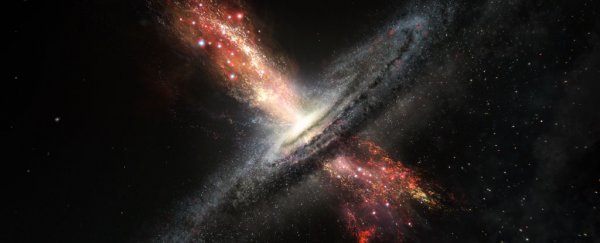For the first time, scientists have observed infant stars being born in the hugely powerful gusts of space wind that blast from supermassive black holes.
While supermassive black holes might be more commonly associated with the phenomenon of consuming and destroying the celestial objects that fall into them, the new observations demonstrate that the blasts of material black holes produce – called ultra-fast outflows – also play a role in redistributing matter throughout the Universe.
"Astronomers have thought for a while that conditions within these outflows could be right for star formation, but no one has seen it actually happening as it's a very difficult observation," says astrophysicist Roberto Maiolino from the University of Cambridge in the UK.
"Our results are exciting because they show unambiguously that stars are being created inside these outflows."
Maiolino's team observed the star-birthing phenomenon taking place in an incredibly distant collision of two galaxies – collectively called IRAS F23128–5919 – located some 600 million light-years from Earth.
That means the merging of these two separate star systems happened around 600 million years ago, but it's taken that long for the light show generated by this colossal clash to reach Earth's telescopes.
Supermassive black holes produce these outflows when matter in the accretion disk that surrounds the black hole becomes heated, and is expelled outward in powerful winds.
These outbursts have the power to actually suppress star formation in neighbouring regions of space – a phenomenon called quenching – but it appears these interstellar blasts can themselves contain baby stars.
Using the European Space Observatory's Very Large Telescope array in Chile, the team identified the light signature of bright, infant stars in the midst of the space wind.
According to the researchers, the stellar population detected in the outflows of IRAS F23128–5919 consists of stars that are less than a few tens of millions of years old – inconceivably ancient to you and me, but mere babies in star terms.
There's a significant number of them too, with the researchers estimating stars in the outflows are forming at a rate of 30 times the mass of the Sun every year, which represents more than a quarter of the total star formation occurring in the IRAS F23128–5919 merger.

Having been ejected from the supermassive black hole at the galaxy's centre, these young stars are travelling outward among streams of other matter at speeds up to hundreds of kilometres per second.
The relative speed of each outflow could end up determining if they successfully clear the black hole (and potentially even the whole star system).
"The stars that form in the wind close to the galaxy centre might slow down and even start heading back inwards," explains one of the team, Helen Russell, "but the stars that form further out in the flow experience less deceleration and can even fly off out of the galaxy altogether."
The team thinks that it's possible this phenomenon could have been seen beforehand with other black hole observations, but previous researchers might have missed the forming stars in ejected matter streams due to less advanced telescopes.
In any case, it's something scientists will be sure to look out for from now on, especially as it's more evidence that supermassive black holes are capable of creating – not just destroying – cosmic bodies.
"If star formation is really occurring in most galactic outflows," says Maiolino, "then this would provide a completely new scenario for our understanding of galaxy evolution."
The findings are reported in Nature.
